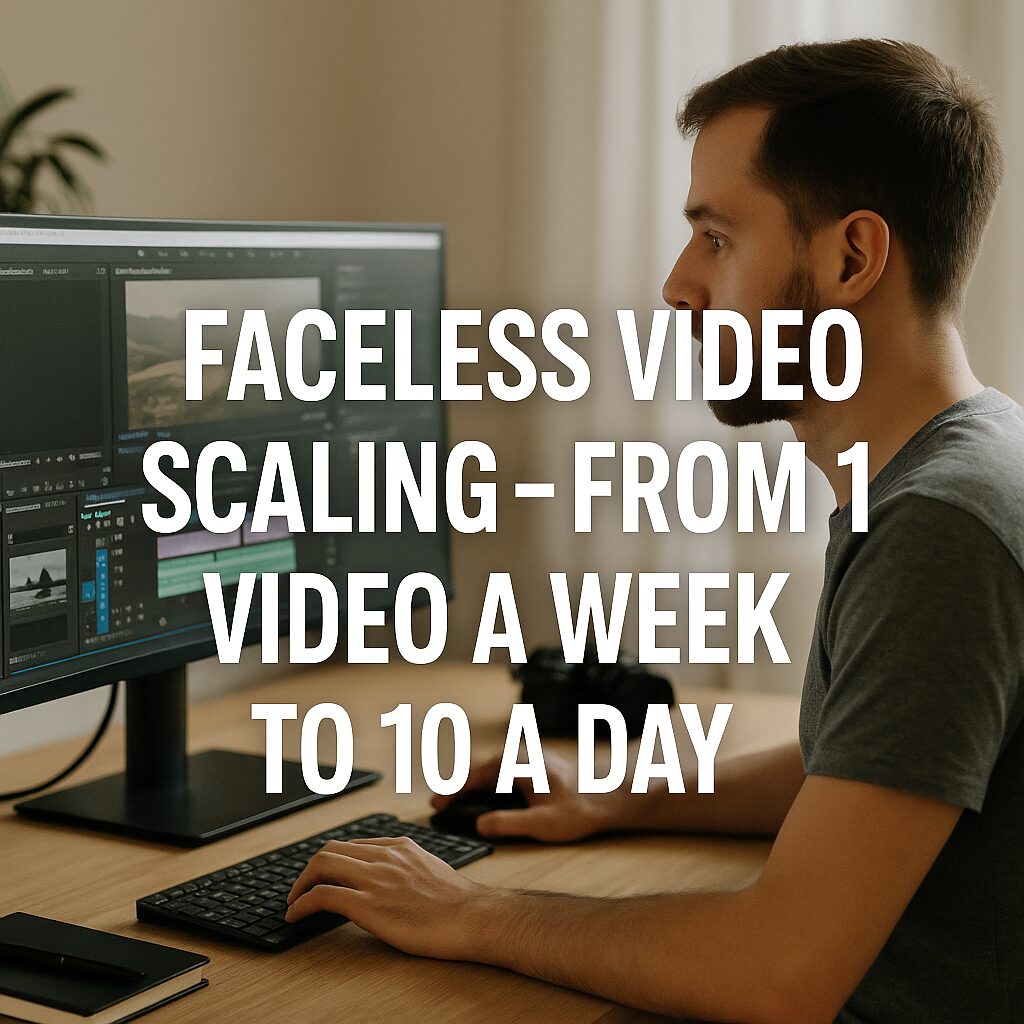How to Scale Without Burning Out (Ultimate 2025 Guide)
You’re making faceless videos, maybe one or two a week. But what if you could scale that to 10 videos a day — and still have time to breathe?
This is your step-by-step plan to go from overworked solo creator to efficient content machine.
Why Scaling Matters in 2025
More content = more impressions.
More impressions = more watch time, more clicks, more revenue.
But scaling isn’t just about working harder.
It’s about working smarter — with the right tools, batching methods, and outsourcing strategies.
Step 1: Build Your Weekly Production Schedule
Let’s break down a 7-day system that delivers 70 videos a week.
Day 1 (Sunday):
- Research 20 trending topics using VidIQ, Google Trends, and Reddit
- Generate 20 scripts with ChatGPT (use custom prompt templates)
Day 2 (Monday):
- Batch record 20 voiceovers using ElevenLabs or AI voices
- Auto-generate visuals via Pictory or CapCut templates
Day 3–5 (Tues–Thurs):
- Edit in bulk (use same intro, transitions, style templates)
- Add subtitles automatically (use SubtitleBee, VEED.io)
Day 6 (Friday):
- Upload & schedule content across platforms (YouTube Shorts, TikTok, Reels)
- Optimize metadata: titles, tags, hashtags, thumbnails (can use Canva templates)
Day 7 (Saturday):
- Analyze performance, tweak hooks, iterate titles
- Rest or repeat high-performing format for next week
Step 2: Automate Repetitive Tasks
If you’re still manually naming files, uploading clips, or copy-pasting titles — stop.
Let tools work for you.
- Zapier: Automate file movement, email alerts, status updates
- Google Sheets + Notion: Track video status, to-do lists, and team communication
- TubeBuddy or Hootsuite: Batch schedule uploads across YouTube and Shorts
- ChatGPT API: Automatically write descriptions and repurpose scripts for IG captions or TikTok hooks
Step 3: Create a Lightweight Team
You don’t need 10 employees. You just need 2–3 key people (or gig workers).
- Script Writer – ChatGPT + light human editing
- Editor – Use CapCut/VEED with your visual template
- VA (Virtual Assistant) – Upload videos, manage titles, create thumbnails
Start with one freelancer on Fiverr/Upwork or use OnlineJobs.ph for affordable VAs from the Philippines.
Step 4: Use Templates for Speed
Templates are your secret weapon.
- Script Template
- Hook (0–3 sec)
- Build Curiosity (3–7 sec)
- Payoff + CTA (7–30 sec)
- Visual Template
- Bold captions
- Zoom effects
- Background music + auto pacing
- Title Formula
- “Stop Doing THIS…”
- “3 Hacks You Didn’t Know About…”
- “Nobody Talks About This…”
Step 5: Track Metrics & Iterate
Scaling only works if you’re improving.
Track weekly:
- Retention rate (above 70% = viral potential)
- Click-through rate (CTR 4–6% is solid)
- Top-performing hook styles or sound effects
Then reinvest:
- Double down on formats that work
- Clone top-performing videos with new twists
- Drop underperforming styles
Bonus: Repurpose Across Platforms
Each video = 3x the exposure
- YouTube Shorts → TikTok → Instagram Reels
- Use auto-cropping tools (InVideo, Pictory)
- Schedule posts via Metricool or Buffer
Add language subtitles (English, Spanish, etc.) using automatic translation tools.
Global reach = more revenue potential.
Scaling Without Burnout
The #1 reason people quit content creation? Burnout.
This system prevents that:
- One creative day (Sunday)
- Four production days (Mon–Thurs)
- Two light/strategy days (Fri–Sat)
You stay focused, efficient, and in control — while your channel grows.
Final Thought
If you want passive income from faceless videos, output = leverage.
Scaling to 10 videos a day isn’t crazy — it’s smart.
You’re not just making content anymore — you’re building a content machine.
Coming Up in Part 9:
Faceless Video Factory – Build a Team or System That Runs Itself
We’ll show you how to transition from solo creator to factory owner, with SOPs, VAs, and content pipelines that run even when you sleep.
